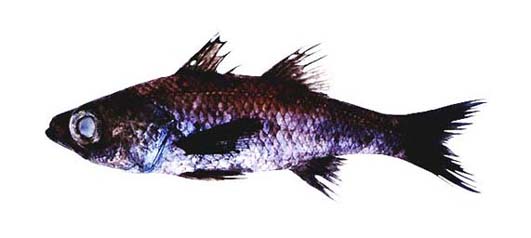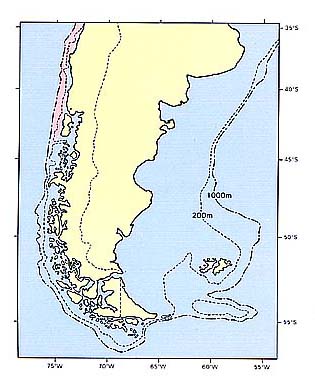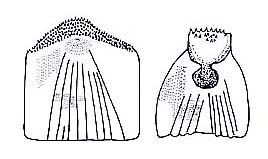テンジクダイ科
- HOME
- デジタル図鑑
- パタゴニア海域の重要水族
- 硬骨魚綱 スズキ目
- テンジクダイ科
テンジクダイ科(Apogonidae)

73 ツマリヤセムツ(Tsumari-yasemutsu)
Epigonus crassicaudatus de Buen, 1959
特 徴:
背鰭7~8棘-1小棘,7~10軟条,臀鰭2棘,8~9軟条,胸鰭16~18軟条,腹鰭1棘,5軟条,鰓耙数7~10+1+18-22=27~33,鰓条骨数7,側線鱗数53~56。頭長は体長の32.2~40.0%,眼径は10.0~11.8%,体高は27.2~31.0%,吻長は8.4~10.2%,両眼間隔は6.1~9.5%,上顎長は13.8~16.1%,尾柄高は12.2~12.5%,胸鰭長は21.9~25.2%,胸鰭長は18.6~24.0%,第1背鰭高は16.7~19.7%,第2背鰭高は18.3~22.6%,臀鰭高は19.1~21.0%。体は延長し,かなり側扁する。吻端から後頭部へかけて隆起し,以後背鰭起部までゆるやかに湾曲する。体長は体高の4倍弱。頭は大きく,体長は頭長の2.8~3.0倍。眼は大きく,頭長は眼径の約3倍で,吻長は眼径よりやや短い。鼻孔は一対で,丸く,後鼻孔は前鼻孔よりわずかに大きい。口は斜位で,伸出可能。上顎後端は眼の中央下に達する。下顎は上顎よりわずかに前方に突出する。両顎歯は非常に小さく,大きな個体ではほとんど消失する。舌上歯はない。鋤骨と口蓋骨には歯がないか,あるとしても微小歯が数本。主鰓蓋骨棘はよく化骨し強い。鰓耙はかなり長く,錐状。擬鰓がある。両眼間隔域はほぼ平坦で,その幅は吻長よりわずかに長い。鱗は大きな櫛鱗で,脱落し易い。側線は単線で,腹縁より背縁に近く走る。胸鰭は低く位置し,中庸,小さな個体では腹鰭とほぼ同長,大きな個体では腹鰭よりやや長い。第1背鰭,第2背鰭,および臀鰭の基底は短い。尾鰭はわずかに二叉する。尾柄部は幅広い。各鰭の棘は強くて鋭い。体長約30cmに達する大型種。
分 布:
チリ沖。
備 考:
本種の幼魚が中層で採集されていることから,本来底生性の本種の生活史の一時期に浮遊期があると考えられる(Mayer, 1974)。
(中村 泉)
Material examined:
10 from Chile (169.8-299.2 mm SL), FAKU CP 147, 309, 311, 504, 505, 508, 523, 526, 527, 557.
Description:
D Ⅶ-Ⅷ-i, 7-10; A Ⅱ, 8-9, P1 16-18; P2 Ⅰ, 5; GR 7-10+1+18-22=27-33; BR 7; LLS 53-56. HL 32.2-40.0% of SL; ED 10.0-11.8; BD 27.2-31.0; SN 8.4-10.2; IO 6.1-9.5; UJ 13.8-16.1; CP 12.2-12.5; P1L 21.9-25.2; P2L 18.6-24.0; D1H 16.7-19.7; D2H 18.3-22.6; AH 19.1-21.0.
Body elongate, fairly compressed, anterodorsal profile rising from tip of snout to occiput, becoming moderately convex from occiput to first dorsal fin base, body depth about 4 times in SL. Head large, 2.8-3.0 times in SL. Eye large, about 3 times in head, longer than snout. Nostrils paired and round, posterior nostril slightly larger. Mouth oblique, protrusible maxilla extending to middle of eye. Lower jaw protruding slightly anterior to upper jaw. Jaw teeth very small or none in larger specimens. No lingual teeth on tongue. Vomer and palatines edentate or with several fine teeth. Opercular spine well ossified, pungent. Gill-rakers fairly long, awl-like. Pseudobranchiae present. Interorbital region fairly flat, its width slightly longer than snout. Scales large ctenoid, fairly deciduous. Lateral line single, running from upper insertion of opercle to caudal fin base on dorsolateral part of body. Pectoral fin moderate in size and low, nearly as long as pelvic fin in smaller specimens or longer than pelvic fin in large specimens. Pelvic fin large, nearly equal to or slightly shorter than pectoral fin, situated slightly posterior to hind insertion of pectoral fin. Bases of first dorsal, second dorsal and anal fins short. Caudal fin weakly forked, with rather deep caudal peduncle. All fin spines very strong and pungent.
Distribution:
Off Chilean coast.
Remarks:
The midwater capture of E. crassicaudus juveniles suggests that the life cycle of the species includes a pelagic stage (Mayer, 1974).
(Izumi NAKAMURA)

Distribution of Epigonus crassicaudatus in Patagonia.

Scale below mid lateral line (left) and lateral line scale (right).
- 1
- 2